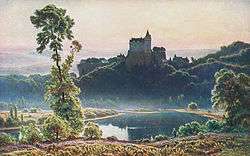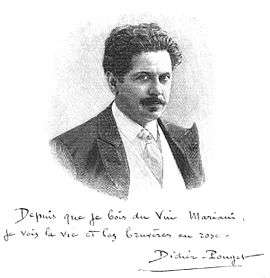William Didier-Pouget
| William Didier-Pouget | |
|---|---|
|
William Didier-Pouget, 1906 engraving | |
| Born |
14 November 1864 Toulouse, Haute-Garonne, France |
| Died |
12 September 1959 (aged 94) Digulleville, Basse-Normandie, France |
| Resting place | Cimetière de Montmartre |
| Nationality | French |
| Known for | Painting |
| Notable work | Bruyère à l'aube, Morning mists in the valley of the Creuse, Morning in the valley of Correze, The valley of Creuse, La vallée du Lot, Saint-Cirq-La-Popie, Fin d'après-midi dans la Hague, La Vallée de L'Aumance, Paysage (Musée des Beaux-Arts de Bordeaux), Bruyères en fleurs, brume du matin (Musée Fabre, Montpellier), Lever de lune sur la lande (Musée, Barbezieux-Saint-Hilaire) |
| Movement | Impressionism, "La Peinture Claire" |
| Awards | Officer of the Legion of Honor |
William Didier-Pouget (Toulouse 14 November 1864 - Digulleville 12 September 1959) was a French artist, born in 1864, Toulouse, France, known for his landscape paintings. He focused primarily on the countryside of southern France, infusing his landscapes, always painted outdoors (en plein air), with light and color. Didier-Pouget is associated with the later phase of Impressionism, although not actually identified with the group of artists typically known as the Impressionists.[1] His career as an exhibiting artist stems from 1886 onwards.[2] He was a member of the Société des Artistes Français, a member of l'École de Crozant[3] and Société des Peintres de Montagne.[4] Also, laureate of l'Institut au Concours Troyon, Officer of the order of Nichan Iftikar (Order of Glory (Tunisia))[5] and Officer of the Legion of Honour.[6]
Early life

William Didier-Pouget was the son of a newspaper editor. Antoine Paul Jules Edgar Pouget, a nature lover, encouraged William in his ambition to become an artist. The two would often take long walks together, the elder pointing out natural phenomena while discussing methods of their pictorial representation. He related biographical details of the great artists, past and present, and in every possible way trained the boy while rousing his ambition.[7]
Didier-Pouget began his formal art training at the École des Beaux-Arts in the city of Toulouse. He later studied at the Académie de Paris with Amédée (Jean Amédée) Baudit, the famed French landscape painter, and made his debut at the Salon de Paris in 1886. He later studied with Louis-Augustin Auguin, an associate of Gustave Courbet and Jean-Baptiste Corot. Ultimately, Didier-Pouget was accepted into the studio of Maxime Lalanne, the celebrated artist, illustrator and etcher. Under these influences many profitable years followed. The seeds were sown for what would become Didier-Pouget's fruitful career as an artist.[7]
William Didier-Pouget married Caroline Salley (1863–1949) and had a daughter, Yvonne (1885–1971). Yvonne Aubert-Didier-Pouget (aka Charline Abbeille) became an artist painter and miniaturist.[8]
Painting career
%2C_oil_on_canvas%2C_240_x_170_cm.jpg)
In Toulouse, the young artist had already been regarded as a prodigy of talent, and great things were expected of him. Paintings were exhibited in the provinces, attracting much attention, and found many purchasers. Encouraged, Didier-Pouget sought a wider audience, and moved to Paris; a wise step for his career. From 1886 he exhibited regularly at the Salons, each new season showing a marked advancement in his art, "bringing to the world of Paris new and delightful colour-schemes and vivid compositions". (Dewhurst, 1904)[7]
During his early years Didier-Pouget's landscape paintings were temperate and ethereal with a poetic atmosphere. Progressively he began to specialize in a style that would build his considerable reputation all the way to the United States, with many commissioned works both at home and abroad. The artist took pleasure in expressing the tranquil ambiance of river scenes. The soft poesy of his mountainous landscapes are suggestive of Auguin, a disciple of Corot. Didier-Pouget, part of the same school, had cultivated from their groundwork the idea of leaving the foreground largely unobstructed. The importance he attaches to the tree is eloquent; representing for him the opacity of the earth in contrast to the unburdened transparency of the sky, with its silhouette projected onto the horizon. The strong bichromy of his paintings evokes the short time span of the twilight, just after sunset or before the sunrise.[9]
Didier-Pouget excelled in depicting morning and sunset effects. "His scenes of heather bathed in sunshine or glistening with the dew of an autumnal sunrise are rendered with an exceptional verisimilitude, strength, and truth", wrote Dewhurst in 1901.[10]

During the height of his career, Didier-Pouget's favorite subjects were beautiful fields of heather in the fog, forests filled with light, plateaus in the Creuse Valley, and the Dordogne River winding through the hills. His clients at the time included George I of Greece, Carnegie Museum, the embassy at Saint-Petersbourg, conseil municipal au Capitule de Toulouse, Musée des Ursulines de Mâcon, Palais des Beaux-Arts de la Ville de Paris (Petit Palais), Conseil Municipal de l'Hôtel de Ville (Saint-Bertrand-de-Comminges), and Raymond Poincaré (president of France from 1913 to 1920).[2]
In April 1903, Didier-Pouget exhibited in the United States at the Newark (NJ) Library Art Gallery, and was mentioned in the New-York Tribune, 20 April 1903. The exhibition was organized by George A. Dowden.[11]
Wynford Dewhurst wrote again of Didier-Pouget in 1904: "If the greatest art is to represent an impression of Nature at her best, then the work of Didier-Pouget is great. 'It is truly worth while being a painter to have produced any one of these,' writes the critic of Le Temps. The artist loves best to represent Nature in her peaceful moods, and generally seeks the solitudes of the exquisite hills, valleys, and rivers of the Tarbes countryside, or the rich watershed of La Creuse. Here, in the fresh early-morn, charged with dew and mist, he finds his subjects, overlooking magnificent panoramas of river, hillsides covered with heather, across valleys and plains from which loom out sculpturesque masses of foliage, dark and strong against the blue mist and distant mountain ridge. The painter prefers Nature serene and undisturbed, and introduces but little incident."(Wynford Dewhurst, 1904)[7]
He paints the twilight with passion, the waters that glide capriciously beneath the greenery, the flowering heather, the marvelous heather...for the pleasure of the eye [...] These fine droplets that illuminate spontaneous bursts of light in the works of Théodore Rousseau, or the delicate incandescent aura of Camille Corot, are revealed in Didier-Pouget.[5]

Didier-Pouget was named Chevalier de la Legion d'Honneur 15 January 1901, breveted 23 March 1901 and received his decoration as Chevalier de la Legion d'Honneur 28 February 1901. He exhibited at various venues and won the gold medal at the Exposition universelle et internationale (1913). He was subsequently selected as a member of the Jury and became a senior member of the Société des Artistes Français. Didier-Pouget at this time was living in a large studio at 12 Boulevard de Clichy, Paris. On 18 July 1933 Didier-Pouget was promoted to Officier de la Legion d'Honneur by the President of the Third Republic, Albert François Lebrun (President of France from 1932 to 1940).[6]
The artist died in Digulleville, France in 1959 and rests in the 5th division of the Cimetière de Montmartre in Paris, with his parents, wife and daughter.[12]
Works
 William Didier-Pouget, ca.1902-1903, Hauts Plateaux de la Corrèze, oil on canvas, 47.5 x 83.5 cm. (18 3/4 x 32 3/4 in.). Sale, Bonhams London, Tuesday, March 27, 2007, Lot 76 (entitled Bruyères en fleurs).
William Didier-Pouget, ca.1902-1903, Hauts Plateaux de la Corrèze, oil on canvas, 47.5 x 83.5 cm. (18 3/4 x 32 3/4 in.). Sale, Bonhams London, Tuesday, March 27, 2007, Lot 76 (entitled Bruyères en fleurs). William Didier-Pouget, ca.1907-1908, Bruyères en Fleurs, Le Matin, oil on canvas, 129.5 x 209.6 cm (51 x 82.5 inches). Sale, Sotheby's New York: Thursday, October 24, 1996, Lot 302 (entitled Bruyeres en fleurs: Le matin).
William Didier-Pouget, ca.1907-1908, Bruyères en Fleurs, Le Matin, oil on canvas, 129.5 x 209.6 cm (51 x 82.5 inches). Sale, Sotheby's New York: Thursday, October 24, 1996, Lot 302 (entitled Bruyeres en fleurs: Le matin).%2C_oil_on_canvas%2C_182.9_x_251.8_cm%2C_detail.jpeg) William Didier-Pouget, ca.1907-1908, Le Matin, Bruyères en Fleurs (Auvergne), oil on canvas, 182.9 x 251.8 cm (detail). Sale: Sotheby's New York, Wednesday, October 13, 1993, Lot 16 (entitled Ruins of Crozant (Creuze)).
William Didier-Pouget, ca.1907-1908, Le Matin, Bruyères en Fleurs (Auvergne), oil on canvas, 182.9 x 251.8 cm (detail). Sale: Sotheby's New York, Wednesday, October 13, 1993, Lot 16 (entitled Ruins of Crozant (Creuze)). William Didier-Pouget, Lande aux Bruyères, Plateau de Ger (Hautes-Pyrénées), oil on canvas, 55 x 85 cm, Collection d'Art de la Ville de Paris, Palais des Beaux-Arts, Paris.
William Didier-Pouget, Lande aux Bruyères, Plateau de Ger (Hautes-Pyrénées), oil on canvas, 55 x 85 cm, Collection d'Art de la Ville de Paris, Palais des Beaux-Arts, Paris. William Didier-Pouget, Matinée dans le Limousin, Bruyères en fleurs, postcard, Salon 1910.
William Didier-Pouget, Matinée dans le Limousin, Bruyères en fleurs, postcard, Salon 1910. William Didier-Pouget in his studio, 12 Boulevard de Clichy, Paris, circa 1907, Postcard (detail). This postcard was postmarked and mailed in 1907.
William Didier-Pouget in his studio, 12 Boulevard de Clichy, Paris, circa 1907, Postcard (detail). This postcard was postmarked and mailed in 1907.
References
- ↑ Base de données bibliographiques Malraux, Le Paysagiste Didier-Pouget, by Joseph Uzanne, Editor Eugène Figuière, Paris, 1923
- 1 2 Peintre Bordelais, Didier-Pouget
- ↑ Brive Roche, 1908, Bulletin de la Société scientifique historique et archéologique de la Corrèze
- ↑ New York Times, Current Art Matters, April 14, 1907
- 1 2 Figures Contemporaines, L'Album Mariani, 1906, E. Flammarion (Paris), Vol. 10
- 1 2 Archives nationales, Ministère de la Culture
- 1 2 3 4 Wynford Dewhurst, 1904, Impressionist Painting, its genesis and development, Chapter X, La Peinture Claire: Glaus, Le Sidaner, Besnard, Didier-Pouget, pp. 85-87, 102, Fogg Art Museum, Harvard University, Fine Arts Library
- ↑ Cimetière de Montmartre
- ↑ Benoît Mahuel, Culture.gouv.fr
- ↑ Wynford Dewhurst, The International Studio (The Studio), 1901, The Work of Didier-Pouget, Landscape Painter, Issue: 94, p. 247
- ↑ W. Didier-Pouget, Heather in Bloom, Exhibition at the Newark (NJ) Library Art Gallery, April 1903. New-York Tribune. (New York, N.Y.), 20 April 1903. Chronicling America: Historic American Newspapers. Lib. of Congress
- ↑ Les Cimetieres
External links
- Base Léonore Archives William Didier-Pouget
- Jonconde, Portail des collection des Musée de France
- Ministère de la culture - base Mémoire, Didier-Pouget
- Base Palissy, Inventaire général du patrimoine culturel
- Archives Nationales, Base Arcade, site de Paris
- ARCHIM: albums de photographies dits "des Salons"
- Didier-Pouget, Gallica, Bibliothèque nationale de France
- Christie's New York, 19th Century European Art & Orientalist Art, 12 April 2007
- Christie's New York, Orientalist Art, 19th Century European Art, 25 October 2006
- The Metropolitan Museum of Art, Manuscripts, William Didier-Pouget letter to Charles Warren Cram, 1890
- Réunion des Musées Nationaux, Grand Palais, Agence photographique, Didier-Pouget
